List of musical symbols facts for kids
Musical symbols are marks and symbols in musical notation that indicate various aspects of how a piece of music is to be performed. There are symbols to communicate information about many musical elements, including pitch, duration, dynamics, or articulation of musical notes; tempo, metre, form (e.g., whether sections are repeated), and details about specific playing techniques (e.g., which fingers, keys, or pedals are to be used, whether a string instrument should be bowed or plucked, or whether the bow of a string instrument should move up or down).
Contents
Lines
 |
Staff/stave The five-line staff (often "stave" in British usage) is used to indicate pitch. Each line or space indicates the pitch belonging to a note with a letter name: A, B, C, D, E, F, G. Moving vertically upwards, the letter names proceed alphabetically with the alternating lines and spaces, and represent ascending pitches. The A-G pattern repeats continually—the note above "G" is always another "A". A clef is almost always added, which assigns one specific pitch to one specific line; the other lines and spaces are determined alphabetically as described. |
 |
Ledger or leger lines These additional lines (and the spaces they form) indicate pitches above or below the staff. The diagram shows a single ledger line above and below the staff but multiple ledger lines can be used. |
 |
Bar line (or barline) Bar lines separate measures ("bars") of music according to the indicated time signature. They sometimes extend through multiple staves to group them together when a grand staff is used or when indicating groups of similar instruments in a conductor's score. |
 |
Double bar line These indicate some change in the music, such as a new musical section, or a new key/time signature. |
 |
Bold double bar line These indicate the conclusion of a movement or composition. |
 |
Dotted bar line These can be used to subdivide measures of complex meter into shorter segments for ease of reading. |
 |
Brace A brace is used to connect two or more lines of music that are played simultaneously, usually by a single player, generally when using a grand staff. The grand staff is used for piano, harp, organ, and some pitched percussion instruments. The brace is occasionally called an accolade in some old texts and can vary in design and style. |
 |
Bracket A bracket is used to connect two or more lines of music that sound simultaneously. In contemporary usage it usually connects staves of individual instruments (e.g., flute and clarinet; two trumpets; etc.) or multiple vocal parts, whereas the brace connects multiple parts for a single instrument (e.g., the right-hand and left-hand staves of a piano or harp part). |
Clefs
A clef assigns one particular pitch to one particular line of the staff on which it is placed. This also effectively defines the pitch range or tessitura of the music on that staff. A clef is usually the leftmost symbol on a staff, although a different clef may appear elsewhere to indicate a change in register. Historically, clefs could be placed on any line on a staff (or even on a space), but modern notation almost exclusively uses treble, bass, alto, and tenor clef.
 |
G clef (Treble clef) The spiral of a G clef (not a point on the spiral, but the center around which the spiral is drawn) shows where the G above middle C is located on the staff. A G clef with the spiral centered on the second line of the staff is called treble clef. The treble clef is the most commonly encountered clef in modern notation. |
Alto clef Tenor clef  |
C clef (Alto and Tenor clefs) The center of a C clef points to the line representing middle C. The first illustration here is centered on the third line on the staff, making that line middle C. When placed there, the clef is called alto clef, mainly used for the viola but sometimes used for other instruments. The second illustration shows the clef centered on the fourth line—called tenor clef. Tenor clef is used for bassoon, cello, trombone, and double bass when the notes get very high, avoiding the use of excessive ledger lines. Until the classical era, C clefs were frequently seen pointing to other lines (it is sometimes called a "movable clef"), mostly in vocal music, but this has been supplanted by the universal use of the treble and bass clefs. Modern editions of music from such periods generally rewrite the original C-clef parts to either treble (female voices), octave treble (tenors), or bass clef (tenors and basses). The C clef was sometimes placed on the third space of the staff (equivalent to an octave treble clef) but this usage is unusual since all other modern clefs are placed on lines. |
 |
F clef (Bass clef) An F clef places the F below middle C on the line between the dots. When placing the F below middle C on the fourth line, as shown here, it is called bass clef, which is by far its most common usage. Bass clef appears nearly as often as treble clef in modern music notation. In older notation, particularly for vocal music, F clefs were sometimes centered on the third line (baritone clef) but this usage has essentially become obsolete. |
 |
Octave clef Treble and bass clefs can be modified by octave numbers. An "8" below the clef (as in the diagram) indicates that pitches will sound an octave lower than they would with the unmodified clef. A "15" below indicates a two-octave shift. These numbers may also be used above the clef to indicate pitches one or two octaves higher. A treble clef with an eight below is the most common version, typically used in music for guitar or tenor voice. Sometimes a shift of one octave up is indicated by drawing two clefs instead of one. |
 |
|
 |
|
 |
|
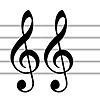 |
|
On a 5-line staff On a single-line staff  |
Neutral clef Used for pitchless instruments, such as percussion instruments, this is not a true clef—the lines and spaces do not indicate pitches—but it occupies the position of a clef. In this case, the lines and spaces indicate specific instruments, such as the different individual instruments in a drum set. It may also be drawn on a single-line staff for single percussion instruments. |
 |
Tablature Also not a true clef—the lines and spaces do not represent pitches—tablature notation is used in place of ordinary staff notation for some string instruments, such as the guitar. The lines represent the strings of an instrument (for standard 6-stringed guitars, six lines would be used). Numbers on the lines show which fret to use. Because the lines represent strings rather than pitches, the spaces between the lines are never used. |
Breaks
 |
Breath mark This symbol tells the performer to take a breath (for singers and aerophones) or leave a slight space (for other instruments). This space does not affect the tempo. For instruments that employ a bow, it indicates to lift the bow and start the next note with a new bowing. |
 |
Caesura A caesura indicates a pause during which time is not counted. |
Accidentals and key signatures
Common accidentals
Accidentals modify the pitch of the notes that follow them on the same staff position within a measure, unless cancelled by an additional accidental.
 |
Flat The flat symbol lowers the pitch of a note by one semitone. |
 |
Sharp The sharp symbol raises the pitch of a note by one semitone. |
 |
Natural A natural cancels a sharp or flat. This sharp or flat may have been indicated as an accidental or defined by the key signature. |
 |
Double flat A double flat lowers the pitch of a note by two semitones. |
 |
Double sharp A double sharp raises the pitch of a note by two semitones. |
Key signatures
Key signatures indicate which notes are to be played as sharps or flats in the music that follows, showing up to seven sharps or flats. Notes that are shown as sharp or flat in a key signature will be played that way in every octave—e.g., a key signature with a B♭ indicates that every B is played as a B♭. A key signature indicates the prevailing key of the music and eliminates the need to use accidentals for the notes that are always flat or sharp in that key. A key signature with no flats or sharps generally indicates the key of C major or A minor, but can also indicate that pitches will be notated with accidentals as required. The key signature examples shown here are as they would appear in treble clef.
Flat key signatures
Sharp key signatures
Microtones
There is no universally accepted notation for microtonal music, with varying systems being used depending on the situation. A common notation for quarter tones involves writing the fraction ¼ next to an arrow pointing up or down. Below are other forms of notation:
 |
Demiflat / Half flat Lowers the pitch of a note by one quarter tone. (Another notation for the demiflat is a flat with a diagonal slash through its stem. In systems where pitches are divided into intervals smaller than a quarter tone, the slashed flat represents a lower note than the reversed flat.) |
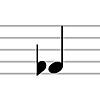 |
|
 |
Flat-and-a-half (sesquiflat) Lowers the pitch of a note by three quarter tones. As with a demiflat, a slashed double-flat symbol is also used. |
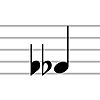 |
|
 |
Demisharp / Half sharp Raises the pitch of a note by one quarter tone. |
 |
Sharp-and-a-half (sesquisharp) Raises the pitch of a note by three quarter tones. Occasionally represented with two vertical and three diagonal bars instead. |
 |
Harmonic flat Lowers the pitch of a note to a pitch matching the indicated number in the harmonic series of the root (bottom) of the chord. Illustrated is a specific example, the septimal flat, in the context of a septimal minor third, in which the E♭ is tuned exactly to a 7:6 frequency ratio with the root (C). |
A symbol with one vertical and three diagonal bars indicates a sharp with some form of alternate tuning.

In 19 equal temperament, where a whole tone is divided into three steps instead of two, music is typically notated in a way that flats and sharps are not usually enharmonic (thus a C♯ represents a third of a step lower than D♭); this has the advantage of not requiring any nonstandard notation.
Time signatures
Most music has a rhythmic pulse with a uniform number of beats—each segment of this pulse is shown as a measure. Time signatures indicate the number of beats in each measure (the top number) and also show what type of note represents a single beat (the bottom number). There may be any number of beats in a measure but the most common by far are multiples of 2 and/or 3 (i.e., 2, 3, 4, and 6). Likewise, any note length can be used to represent a beat, but a quarter note (indicated by a bottom number of "4") or eighth note (bottom number of "8") are by far the most common.
 |
Simple time signatures This example shows that each measure is the length of three quarter notes (crotchets). 3 4 is pronounced as "three-four" or "three-quarter time". |
 |
Compound time signatures In a compound meter, there is an additional rhythmic grouping within each measure. This example shows 6 8 time, indicating 6 beats per measure, with an eighth note representing one beat. The rhythm within each measure is divided into two groups of three eighth notes each (notated by beaming in groups of three). This indicates a pulse that follows the eighth notes (as expected) along with a pulse that follows a dotted quarter note (equivalent to three eighth notes). |
 |
Common time This symbol represents 4 4 time—four beats per measure with a quarter note representing one beat. It derives from the broken circle that represented "imperfect" duple meter in fourteenth-century mensural time signatures. |
 |
Alla breve or cut time This symbol represents 2 2 time—two beats per measure with a half-note representing one beat. |
 |
Metronome mark This notation is used to precisely define the tempo of the music by assigning an absolute duration to each beat. This example indicates a tempo of 120 quarter notes (crotchets) per minute. Many publishers precede the marking with letters "M.M.", referring to Maelzel's Metronome. This is a tempo marking, not a time signature—it is independent of how the beats are grouped (the top number in a time signature), although it defines the tempo in terms of the counting note (the bottom number). |
Note relationships
 |
Tie When tied together, two notes with the same pitch are played as a single note. The length of this single note is the sum of the time values of the two tied notes. The symbol for the tie and the symbol for the slur appear the same, but a tie can only join two notes of the same pitch. |
  |
Slur While the first note of a slurred group is articulated, the others are not. For bowed instruments this entails playing the notes in a single bow movement, for wind instruments (aerophones) the first note of the slurred group is tongued but the rest of the notes are not—they are played in one continuous breath. On other instruments, like pitched percussion instruments, the notes are connected in a phrase, as if a singer were to sing them in a single breath. In certain contexts a slur may instead indicate that the notes are to be played legato, in which case rearticulation is permitted. While the slur symbol and the tie symbol appear the same, a tie can only connect exactly two notes of the same pitch; a slur can connect two or more of any pitches. In vocal music a slur normally indicates that notes under the slur should be sung to a single syllable. A phrase mark (or less commonly, ligature) is visually identical to a slur but connects a passage of music over several measures. A phrase mark indicates a musical phrase and may not necessarily require that the music be slurred. |
 |
Glissando or Portamento A continuous, uninterrupted glide from one note to the next that includes the pitches between. Some instruments, such as the trombone, timpani, non-fretted string instruments like the cello, electronic instruments, and the human voice can make this glide continuously (portamento), while other instruments such as the piano, harp, or mallet instruments blur the discrete pitches between the start and end notes to mimic a continuous slide (glissando). |
 |
Tuplet A tuplet is a group of notes that would not normally fit into the rhythmic space they occupy. The example shown is a quarter-note triplet—three quarter notes are to be played in the space that would normally contain two. (To determine how many "normal" notes are being replaced by the tuplet, it is sometimes necessary to examine the context.) While triplets are the most common version, many other tuplets are possible: five notes in the space of four, seven notes in the space of eight, etc. Specific tuplets are named according to the number of grouped notes; e.g., duplets, triplets, quadruplets, etc. |
 |
Chord A chord is several notes sounded simultaneously. Two-note chords are called dyads, three-note chords built by using the interval of a third are called triads. |
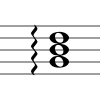 |
Arpeggiated chord A chord with notes played in rapid succession, usually ascending, each note being sustained as the others are played. It is also called a broken chord, a rolled chord, or an arpeggio. |
Dynamics
Dynamics are indicators of the relative intensity or volume of a musical line.
Rarely, even softer or louder dynamic levels are indicated by adding more ps or fs. While ppp is called "pianississimo" and fff is called "fortississimo", these words (formed by adding an additional "iss") are not proper Italian.
Dynamics are relative, and the meaning of each level is at the discretion of the performer or the conductor. Laws to curb high noise levels in the workplace have changed the interpretation of very loud dynamics in some large orchestral works, as noise levels within the orchestra itself can easily exceed safe levels.
Articulation marks
Articulations specify the length, volume, and style of attack of individual notes. This category includes accents. Articulations can be combined with one another and may appear in conjunction with phrasing marks (above). Any of these markings may be placed either above or below a note.
Ornaments
Ornaments modify the pitch pattern of individual notes.
 |
Tremolo A rapidly repeated note. If the tremolo is between two notes, then they are played in rapid alternation. The number of slashes through the stem (or number of diagonal bars between two notes) indicates the frequency to repeat (or alternate) the note. As shown here, the note is to be repeated at a demisemiquaver (thirty-second note) rate, but it is a common convention for three slashes to be interpreted as "as fast as possible", or at any rate at a speed to be left to the player's judgment. In percussion notation, tremolos indicate rolls, diddles, and drags. Typically, a single tremolo line on a sufficiently short note (such as a sixteenth) is played as a drag, and a combination of three stem and tremolo lines indicates a double-stroke roll (or a single-stroke roll, in the case of timpani, mallet percussion and some untuned percussion instruments such as triangle and bass drum) for a period equivalent to the duration of the note. In other cases, the interpretation of tremolos is highly variable, and should be examined by the director and performers. The tremolo symbol also represents flutter-tonguing. |
  |
Trill A rapid alternation between the specified note and the next higher note (determined by key signature) within its duration, also called a "shake". When followed by a wavy horizontal line, this symbol indicates an extended, or running, trill. In music up to the time of Haydn or Mozart the trill begins on the upper auxiliary note. In percussion notation, a trill is sometimes used to indicate a tremolo. In French baroque notation, the trill, or tremblement, was notated as a small cross above or beside the note. |
 |
Upper mordent Rapidly play the principal note, the next higher note (according to key signature) then return to the principal note for the remaining duration. In some music, the mordent begins on the auxiliary note, and the alternation between the two notes may be extended. (In other words, in some music, the upper-mordent sign means exactly the same as the trill sign.) Regardless of the style of music, the pattern finishes on the principal note. In handbells, this symbol is a "shake" and indicates the rapid shaking of the bells for the duration of the note. |
 |
Lower mordent (inverted) Rapidly play the principal note, the note below it, then return to the principal note for the remaining duration. In much music, the mordent begins on the auxiliary note, and the alternation between the two notes may be extended. |
   |
Gruppetto or Turn When placed directly above the note, the turn (also known as a gruppetto) indicates a sequence of upper auxiliary note, principal note, lower auxiliary note, and a return to the principal note. When placed to the right of the note, the principal note is played first, followed by the above pattern. Placing a vertical line through the turn symbol or inverting it, it indicates an inverted turn, in which the order of the auxiliary notes is reversed. |
 |
Appoggiatura The first half of the principal note's duration has the pitch of the grace note (the first two-thirds if the principal note is a dotted note). |
 |
Acciaccatura The acciaccatura is of very brief duration, as though brushed on the way to the principal note, which receives virtually all of its notated duration. In some styles of music, the acciaccatura is played exactly on the beat and the principal note is marginally late; in other styles, the acciaccatura is marginally early and the principal note is on the beat. It is also possible on some instruments to play both notes exactly on the beat and then quickly release the acciaccatura. In percussion notation, the acciaccatura symbol denotes the flam, the miniature note still positioned behind the main note but on the same line or space of the staff. The flam note is usually played just before the natural durational subdivision the main note is played on, with the timing and duration of the main note remaining unchanged. Also known by the English translation of the Italian term, crushed note, and in German as Zusammenschlag (simultaneous stroke). |
Octave signs
 |
Ottava alta 8va is placed above the staff to indicate that the passage is to be played one octave higher. |
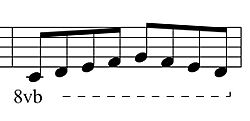 |
Ottava bassa 8vb is placed below the staff to indicate that the passage is to be played one octave lower. |
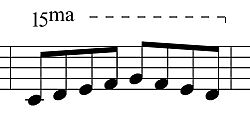 |
Quindicesima alta 15ma is placed above the staff to indicate that the passage is to be played two octaves higher. |
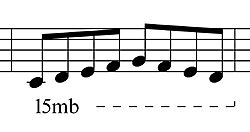 |
Quindicesima bassa 15mb is placed below the staff to indicate that the passage is to be played two octaves lower. |
8va and 15ma are sometimes abbreviated further to 8 and 15. When they appear below the staff, the word bassa is sometimes added.
Repetition and codas
Instrument-specific notation
Bowed string instruments
 |
Left-hand pizzicato or Stopped note A note on a stringed instrument where the string is plucked with the left hand (the hand that usually stops the strings) rather than bowed. On the horn, this accent indicates a "stopped note" (a note played with the stopping hand shoved further into the bell of the horn). In percussion this notation denotes, among many other specific uses, to close the hi-hat by pressing the pedal, or that an instrument is to be "choked" (muted with the hand). |
 |
Snap pizzicato On a stringed instrument, a note played by stretching a string away from the frame of the instrument and letting it go, making it "snap" against the frame. Also known as a Bartók pizzicato. |
 |
Natural harmonic or Open note On a stringed instrument, this means to play a natural harmonic (also called flageolet). Sometimes, it also denotes that the note to be played is an open string. On a valved brass instrument, it means to play the note "open" (without lowering any valve, or without mute). In organ notation, this means to play a pedal note with the heel (above the note, use the right foot; below the note, use the left foot). In percussion notation this denotes, among many other specific uses, to open the hi-hat by releasing the pedal, or allow an instrument to ring. |
 |
Up bow or Sull'arco On a bowed string instrument, the note is played while drawing the bow upward. On a plucked string instrument played with a plectrum or pick (such as a guitar played pickstyle or a mandolin), the note is played with an upstroke. |
 |
Down bow or Giù arco In contrast to the up bow, here the bow is drawn downward to create sound. On a plucked string instrument played with a plectrum or pick (such as a guitar played pickstyle or a mandolin), the note is played with a downstroke. |
| Con sordino ("with mute") This symbol indicates that a mute is to be used. |
|
| Senza sordino ("without mute") This symbol indicates that no mute is used. It is generally seen after a muted section. |
Guitar
The guitar has a fingerpicking notation system derived from the names of the fingers in Spanish or Latin. They are written above, below, or beside the note to which they are attached. They read as follows:
| Symbol | Spanish | Italian | Latin | English | French | Portuguese |
|---|---|---|---|---|---|---|
| p | pulgar | pollice | pollex | thumb | pouce | polegar |
| i | índice | indice | index | index | index | indicador |
| m | medio | medio | media | middle | majeur ou médius | médio |
| a | anular | anulare | anularis | ring | annulaire | anular |
| c, x, e, q | meñique | mignolo | minimus | little | auriculaire | mínimo |
Piano
Pedal marks
Pedal marks appear in music for instruments with sustain pedals, such as the piano, vibraphone and chimes.
Other piano notation
| Left hand | Right hand | |
|---|---|---|
| English | l.h. | R.H. |
| left hand | right hand | |
| German | l.H. | r.H. |
| linke Hand | rechte Hand | |
| French | m.g. | m.d. |
| main gauche | main droite | |
| Italian | m.s. | m.d. |
| mano sinistra | mano destra | |
| Spanish | m.i. | m.d. |
| mano izquierda | mano derecha |
| 1, 2, 3, 4, 5 | Finger identifications: 1 = thumb 2 = index 3 = middle 4 = ring 5 = little |
Old (pre-1940) tutors published in the UK may use "English fingering". + for thumb, then 1 (index), 2 (middle), 3 (ring) and 4 (little).
Other stringed instruments
(With the exception of harp)
| 0, 1, 2, 3, 4 | Finger identifications: 0 = open string (no finger used) 1 = index 2 = middle 3 = ring 4 = little The thumb is also used by the cello and bass, usually denoted by ϙ (a circle with a line coming out the bottom), or, more rarely, a T. |
See also Fingerstyle guitar#Notation.
Harp
Fingering numbers are similar to piano, except there is no 5 as the little finger is not used in playing the harp.
1 = thumb, 2 = index finger, 3 = middle finger, 4 = ring finger.
Four-mallet percussion
| 1, 2, 3, 4 | Mallet identifications: 1 = Far left mallet 2 = Inner-left mallet 3 = Inner-right mallet 4 = Far right mallet |
| Some systems reverse the numbers (e.g., 4 = Far-left mallet, 3 = Inner-left mallet, etc.) |
Six-mallet percussion
| 1, 2, 3, 4, 5, 6 | Mallet identifications: 1 = Far-left mallet 2 = Middle-left mallet 3 = Inner-left mallet 4 = Inner-right mallet 5 = Middle-right mallet 6 = Far-right mallet |
Numbers for six-mallet percussion may be reversed as well.
Organ
The organ has many different abbreviations for its keyboards in European languages.
| Great | Swell | Choir | Pedal | Solo | Orchestral | Antiphonal | Echo | Positiv | |
|---|---|---|---|---|---|---|---|---|---|
| English | Great | Swell | Choir | Pedal | Solo | Orchestral | Antiphonal | Echo | Positiv |
| Gt. or G | Sw. or S | C. or Ch. | Ped. or Pd. | So. | Orch. | Ant. | Echo. | Pos. | |
| German | Hauptwerk or Oberwerk | Schwellwerk or Brustwerk | Chor | Pedale | Solo | Orchester | Antiphonal | Widerhall | Positiv |
| Hw. or Ow. | Sw. or Bw. | Ch. | Ped. | Sol. | Orch. | Ant. | Echo. | Pos. | |
| French | Grand-Orgue | Recit | Grand-Chœur | Pédale | Solo | Bombarde | Antiphonaire | Écho | Positif |
| G.O. | R. | G.C. | Ped. or Péd. | Sol. | Bom. or B. | Ant. (rare) | Écho. | Pos. | |
| Dutch | Hoofdwerk | Zwelwerk | Koor | Pedaal | Solo | Bovenwerk | Antifonaal | Echo | Rugwerk |
| Hw. | Zw. | K. | Ped. | Sol. or Solo | Bw. (not to be confused with German Brustwerk) | Ant. | Echo | Rw. (not to be confused with French recit) |
See also
 In Spanish: Signos musicales para niños
In Spanish: Signos musicales para niños
- Singing
- Musical instruments
- Cluster
- Graphic notation
- Music theory
- Glossary of musical terminology
- Musical Symbols (Unicode block)
- Shape note
- Musical Symbols (disambiguation)




















